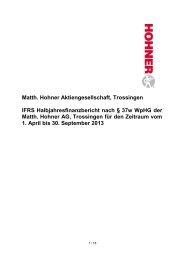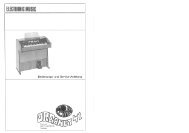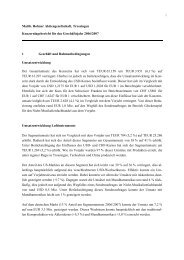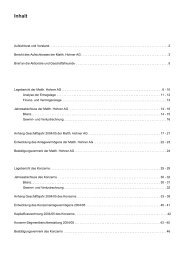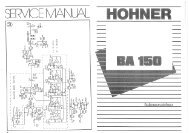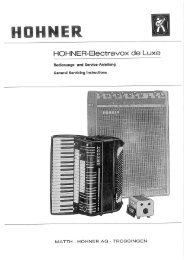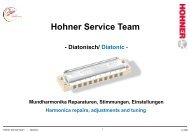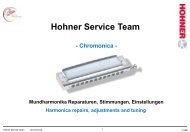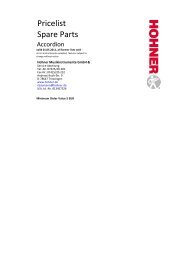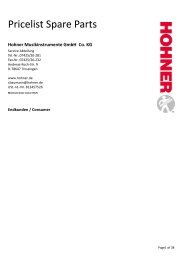Matth. Hohner AG
Matth. Hohner AG
Matth. Hohner AG
You also want an ePaper? Increase the reach of your titles
YUMPU automatically turns print PDFs into web optimized ePapers that Google loves.
Notes to the Consolidated Financial Statements for Business Year 2010/2011<br />
Property, plant and equipment<br />
Property, plant and equipment are stated at historical cost less accumulated straight line depreciation<br />
and accumulated impairment losses. The carrying amount of property, plant and equipment is tested for<br />
impairment whenever there is any indication that the carrying amount of an asset may exceed its recoverable<br />
amount.<br />
Buildings are depreciated over a maximum period of 50 years. The ordinary useful life of technical equipment<br />
and machinery is between 5 and 15 years. Other equipment, furniture and fixtures are depreciated over 3 and<br />
15 years.<br />
Profits and losses of the disposal of property, plant and equipment are recorded to other operating income or<br />
other operating expenses.<br />
Property, plant and equipment have no limits of rights of disposal or pledged as securities.<br />
Impairment of assets<br />
The Group measures at each reporting date whether there is any indication that an asset may be impaired. If<br />
there is such an indication or an annual review of an asset requires an impairment loss to be recognized, the<br />
Group estimates the recoverable amount. The recoverable amount of an asset or a cash generating unit is<br />
the higher of its fair value less costs to sell and its value in use. Recoverable amount is determined for every<br />
individual asset, unless the asset does not generate cash inflows that are largely independent of those from<br />
other assets or groups of assets. If the carrying amount of an asset exceeds its recoverable amount, the asset<br />
is considered to be impaired and is depreciated to its recoverable amount.<br />
An entity should assess at each balance sheet date whether there is any indication that an impairment loss<br />
recognized for an asset in prior years may no longer exist or may have decreased. If such indications exist,<br />
the recoverable amount is estimated. An impairment loss from prior years should be reversed if, and only if,<br />
there has been a change in the estimates used to determine the asset’s recoverable amount since the last<br />
impairment loss was recorded. If this is the case, the carrying amount of the asset should be increased to its<br />
recoverable amount.<br />
This increased carrying amount should not exceed the carrying amount that would have been determined<br />
(net of amortization or depreciation) if no impairment loss had been recognized for the asset in prior years.<br />
The amount of the reversal is recognized immediately in the net profit or loss for the period. After a reversal<br />
of an impairment loss is recognized, the depreciation (amortization) charge for the asset should be adjusted<br />
in future periods to allocate the asset’s revised carrying amount, less its residual value (if any), on a systematic<br />
basis over its remaining useful life.<br />
Investments accounted for At-Equity<br />
The Group holds an interest in a joint venture, Shanghai Lansheng – <strong>Hohner</strong> Musical Instruments Co., Ltd.,<br />
Shanghai, China, which is a jointly controlled entity. The Group accounts for its share in the joint venture using<br />
the equity method.<br />
Inventories<br />
Inventories and trading goods are accounted to average acquisition costs. Unfinished and finished goods are<br />
accounted to production costs considering lower net realizable value. Production costs contain direct material<br />
and labor costs as well as variable and fixed production expenses.<br />
So far as necessary, depreciations will be conducted to the net realizable value. The net realizable value is the<br />
estimated sales revenue made in the usual business less estimated required distribution costs.<br />
Write-downs for slow-moving goods (for finished goods and merchandise but not raw materials or semifinished<br />
goods) and the principle of valuation at net realizable value are taken into account.<br />
Raw materials, consumables and supplies, which are used for the production of inventories as well as<br />
unfinished goods won’t be depreciated to a value which is under its acquisition or production costs, if finished<br />
goods in which they are adopted can be prospective sell to production costs or above.<br />
Notes to the CoNsolidated FiNaNCial statemeNts Notes to the CoNsolidated FiNaNCial statemeNts<br />
73



